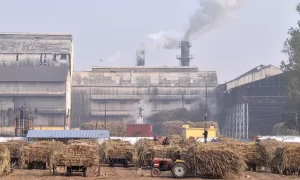Revolutionising India’s Edible Oil Sector: Pathways to Sustainable Growth

India, the fourth-largest player in the global edible oil market, produces key oilseeds like groundnut and mustard but still imports 57% of its edible oil. Strategies like crop diversification, tech adoption, oil palm expansion, value addition, and public-private partnerships aim to boost domestic production. Government initiatives, including the National Mission on Edible Oils, support this self-reliance push.
India ranks fourth in the world after the United States, China, and Brazil in the edible vegetable oil market. India accounts for 15-20% of the world’s oilseed market, 6–7% of global vegetable oil production, and 9–10% of overall world consumption. After food grains, oilseeds are the second most important crop group in India’s agricultural landscape . Groundnut, rapeseed-mustard, soybean, and sunflower are among the nine major oilseed crops that can be grown in the nation given its varied agro-ecological conditions. India is the world’s top producer of castor, safflower, sesame, and niger, while it comes in second for groundnuts and third for rapeseed-mustard. Together, the major producing states of Gujarat, Maharashtra, Madhya Pradesh, and Rajasthan account for more than 77% of the world’s oilseed production. Oilseed production hit a record 41.35 million tonnes in 2022–2023, up 3.39 million tonnes from the year before. However, India still finds it difficult to supply its local demand for edible oils and currently imports 57% of its edible oil demand.
Strategies to attain sustainable growth and reduce import dependency
Crop diversification and retention: Diversifying oilseed cultivation is key to increasing domestic edible oil production. Following methods can be adopted to promote broad base oilseed cultivation:
- The government can assist farmers in switching from traditional crops to locally appropriate, high-yielding oilseeds including peanut, soybean, and sunflower.
- Through educational initiatives that highlight the advantages of crop diversification.
- A consistent supply can also be maintained by enhancing farming methods for currently grown oilseed crops.
According to NITI Aayog, this strategy has the potential to boost oilseed production by 20% (~7.36 million tonnes), by focussing on nine important states: Gujarat, Rajasthan, Madhya Pradesh, Maharashtra, Haryana, Andhra Pradesh, Uttar Pradesh, Karnataka, and Tamil Nadu. The incremental production will aid in moving India closer to self-sufficiency.
Technological advancements: There is a major opportunity to increase edible oil production in India by addressing the gap between current farming practices and advanced agricultural technologies. Research have shown that adopting improved methods can lead to higher yields in oilseed crops. Key strategies include using better seed varieties, modern machinery, and effective management practices such as crop rotation, timely planting, and balanced fertilisation. Implementing efficient crop management techniques can greatly enhance productivity. In addition, enhanced pest and disease management are critical because several oilseed crops are subjected to considerable threats. Finally, careful fertiliser management, especially in intercropping systems, is necessary to ensure that all crops receive nutrients, ultimately boosting productivity and sustainability.
Prioritising palm oil : India’s strategic thrust in oil palm development has been a priority for enhancing edible oil production at home and reducing dependence on imports. The scheme has been showing remarkable growth in the last three decades. From just 8,585 hectares in 1991–1992, the area planted to oil palm has grown to 0.37 million hectares in 2021–2022. Crude palm oil (CPO) and fresh fruit bunches (FFBs) have surged as a result. Presently, 98% of the nation’s oil palm is produced in Andhra Pradesh, Telangana, and Kerala. The oil palm industries in Karnataka, Tamil Nadu, Odisha, Gujarat, and Mizoram are also expanding. The North-East states of Arunachal Pradesh, Assam, Manipur, and Nagaland have recently launched government projects that indicate a growing interest in oil palm planting nationwide. According to a 2020 ICAR-Indian Institute of Oil Palm Research (IIOPR) re-evaluation, 2.8 million hectares in general states and the northeast are considered suitable for oil palm growth. However, the North-East currently uses 0.004 million hectares only, which is the major opportunity of expansion. It is also well known that high yield is obtained in oil palm cultivation. While traditional oilseeds require 15.80 million hectares to produce 4 million tons of oil, oil palm can produce the same amount of output from merely 1 million hectares.

Source: Niti Aayog
Value addition and processing : Edible oil production in India can be greatly enhanced through value addition through processing and refining. According to NITI Aayog, rice bran industry can produce around one million tons of oil that can be blended with popular cooking oils. Harmonization of regulations for rice bran oil with major rice-producing countries under the Codex Committee on fats and oils will help in the increased usage of rice bran oil. Additional steps include the modernisation and geographical balancing of facilities distributed in the extraction plants themselves.
Public-private partnerships: Encouraging public-private partnerships (PPPs) is essential for boosting sustainable edible oil production. By leveraging private sector expertise in technology, marketing, seed production, and area promotion across various oilseed crops, including oil palm, these partnerships can enhance efficiency through buy-back arrangements. Collaboration among government agencies, grower cooperatives, local NGOs, and private stakeholders is vital for achieving sustainable oil palm production while prioritising biodiversity conservation, as seen in initiatives like the Roundtable on Sustainable Palm Oil (RSPO).
Government initiatives

Conclusion
India’s edible oil industry is on the verge of a big change, with a focus on becoming more self-sufficient and less dependent on imports, which currently make up about 57% of the country’s demand. Thanks to its diverse farming conditions, India has the potential to grow key oilseeds like sunflower, soybean, and peanuts. By encouraging crop diversity, adopting modern farming techniques, and expanding oil palm cultivation, India can build a more sustainable future. Programs like the National Mission on Edible Oils are already helping farmers increase local production and processing. This shift will strengthen food security, boost rural incomes, and build a stronger edible oil sector for India’s future.
To Read more about Edible Oil News continue reading Agriinsite.com
Source : IBEF














